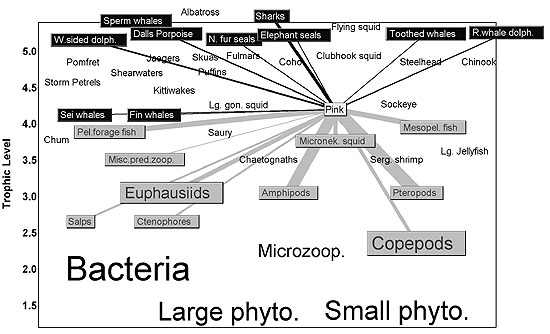Resource Ecology & Ecosystem Modeling Program
Fish Stomach Collection and Lab Analysis
Laboratory analysis was performed on 5,840 groundfish stomachs specimens collected from the
eastern Bering Sea and 172 stomachs from the Aleutian Islands. No stomachs were collected or
returned from the Bering Sea, Gulf of Alaska, or Aleutian Islands during this quarter.
By Troy Buckley
Models of Gulf of Alaska Oceanic Food Webs
The ocean basin of the Gulf of Alaska is an important habitat for the growth of Pacific salmon
(Oncorhynchus spp.). Several North American and Asian salmon stocks put on up to 90% of
their body weight through feeding in this region. In recent years, there has been concern about
the effects of long-term climate change on Pacific salmon growth, as both cold water temperatures
and prey supply are critical to salmon obtaining sufficient body size for their return migrations.
Further, competition for food might limit salmon body size during periods of high salmon abundance,
as in the Gulf of Alaska throughout the 1980s and 1990s.

Figure 1. Food web of the oceanic Alaska Gyre, emphasizing pink salmon.
Prey of pink salmon are shown in grey; predators of pink salmon are shown in black.
Line widths are proportional to
the volume of flow (tons/year).
In an international collaboration through the North Pacific Marine Science Organization (PICES),
AFSC researcher Kerim Aydin was the lead author of a food web model of the oceanic Alaskan Gyre,
which quantified the annual prey and predator budgets for several species of salmon such as pink
salmon, O. gorbuscha (Fig. 1). The modeling was expanded to a detailed seasonal exploration
of factors influencing pink salmon growth, by coupling a bioenergetics model of individual pink salmon
growth and seasonal feeding behavior based on data provided by the University of Washington High Seas
Salmon Program to both the food web model and a seasonal nutrient-phytoplankton-zooplankton model built
by AFSC researcher Bern Megrey through a similar collaboration
The results suggest that the measured rates of pink salmon growth, especially their accelerated spring
and summer growth prior to spawning, are not explained solely by seasonal zooplankton blooms (bottom-up
control). While the zooplankton bloom is important, two additional factors are necessary to explain growth
differences: 1) salmon switching their diet from zooplankton to more nutritious squid as they grow; and
2) a decreasing energetic cost of foraging for salmon in the spring and summer. A possible reason for this
second factor is the concentration of prey in surface waters, which occurs as heat input stratifies the
pelagic water column in the summer, requiring salmon to search less water to find the same amount of food.
The next steps are to test these models with inputs of historical changes in bloom timing, water temperature,
prey supply, and increases in salmon population numbers that have occurred along with measured climate
changes. The hope is that such models will go beyond simple correlations in predicting the effects of future
climate on salmon populations.
By Kerim Aydin
PICES Working Group Meeting
Jennifer Boldt and Anne Hollowed participated in a 2-day workshop held 9-10 February 2004 in Victoria,
British Columbia, as part of a PICES working group under the NMFS Science Board that will provide advice
to the United States with respect to potential implications of recent regime shifts in the North Pacific
for fisheries. The purpose of this meeting was to establish an approach to answering the questions put
forth by the United States, the general outline of the report, and an outline for a June workshop. Further
work will be conducted through correspondence, leading to a draft report to be presented and discussed at
a workshop in late June 2004 in Seattle, Washington. The group plans to have a written report by summer
2004, for review by PICES, with submission to the United States in fall 2004.
By Jennifer Boldt
Fish Food Habits Analysis Tools
Geoff Lang presented “North Pacific Groundfish Diet Data: An Overview of the Resource Ecology and Ecosystems
Management’s Diet Information System (DIS) and Diet Analysis Tool (DAT)’” at the Western Groundfish
Conference, 9-13 February 2004, in Victoria, British Columbia. The poster presented information regarding
the stomach content analysis data from approximately 250,000 North Pacific groundfish. Complete database
details can be found on the AFSC website at
http://www.afsc.noaa.gov/refm/reem/data/Default.htm.
Details of the Resource Ecology and Ecosystem Modeling (REEM) Diet Analysis Tool were also presented. This
MS ACCESS application currently provides many of the diet analysis techniques used by REEM staff in a user
friendly, point-and-click environment with results that formerly required utilization of software packages
such as SPSS and S-Plus. The Diet Analysis Tool output includes a mapping function, descriptive diet tables
and predator-prey scatterplots based on the user’s selection criteria.
By Geoff Lang
New Collaborative Project
Pat Livingston and Geoff Lang met with Dale Kiefer of Science Systems Applications to discuss a collaborative
effort to develop a web-based GIS data visualization of REEM’s North Pacific groundfish diet data. The
visualization software allows users to overlay and visualize spatial relationships among several sources such
as physical and biological data. Potential data sources for this project include REEM’s groundfish diet
database, RACE survey data (catch, surface temperature, temperature/depth profiles), PMEL oceanographic data
(chlorophyll, ice cover, currents). These data would primarily be used internally for exploratory analysis and
to spur internal scientific collaboration. However, summarized data could be made more widely available via
the web as part of the Ocean Biogeographic Information System (OBIS) commissioned by the Census of Marine Life.
By Geoff Lang
>>>continued

|

|
Quarterly sidebar
AFSC Quarterly Research Reports Jan-March 2004
Contents
Feature
ABL Reports
NMML Reports
RACE Reports
REFM Reports
Quarterly Index
Quarterly Home
|

